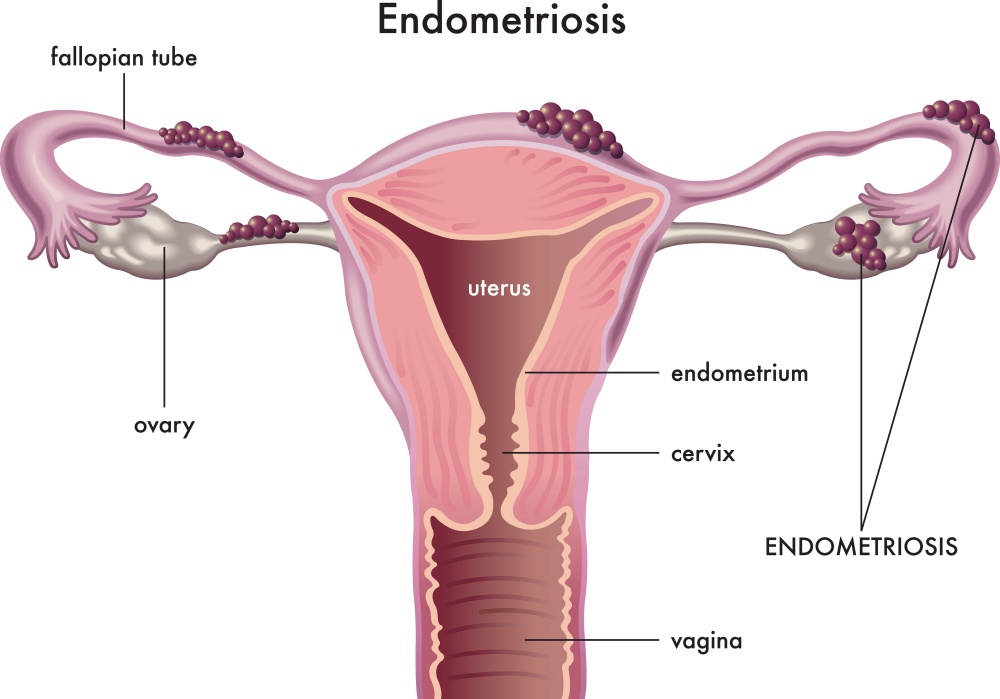Endometriosis affects more than 11% of American women between the ages of 15 and 44 years as well as roughly 10% of women globally according to the Women’s Health division of the U.S. Department of Health and Human Sciences. Notoriously common and painful, this health condition can also make getting pregnant challenging.
This article will highlight what endometriosis is, its symptoms, and treatment options so you can manage its symptoms and improve your quality of life.
What Is Endometriosis?
According to the World Health Organization, endometriosis is a disease wherein tissue that’s similar to the uterus lining grows outside of it. The growth of this additional lining can lead to pain in one’s pelvic region. Other parts of the body can also experience discomfort although its occurrence is rarer.
Symptoms
A common question often asked is, what are the first signs of endometriosis? While endometriosis pain is often associated with typical period discomfort, the severity of endometrial pain is far more intense.
Painful Periods (Dysmenorrhea)
Pelvic pain can begin before a period starts and can intensify with time. Pain in the lower back and stomach is also common.
Discomfort During Intercourse
Women with endometriosis may also experience pain and discomfort during sex.
Painful Bowel Movements and Urination
Discomfort while passing stool or urine can be felt during menstrual periods.
Excessive Bleeding
Besides heavy menstrual flow, women with this condition may also experience bleeding between cycles. This is known as intermenstrual bleeding.
Infertility
The inability to conceive is one of the first signs of endometriosis. In fact, the condition is often discovered when women seek fertility treatments.
Along with the above symptoms, individuals with this condition can also experience fatigue, constipation, diarrhea, and bloating.
Risk Factors
While the cause of this condition remains largely unknown, here are several risk factors that could lead to endometriosis:
- Entering puberty earlier than usual
- Going through menopause later than expected
- Short menstrual cycles of less than 27 days
- Heavy period flow that exceeds 7 days
- High levels of estrogen
- Genetics
- Reproductive tract disorders
How Is Endometriosis Diagnosed?
Doctors will suspect endometriosis based on your symptoms or physical exam. However, a laparoscopy, biopsy, or imaging tests such as an ultrasound or MRI may be used to confirm the condition.
Laparoscopy
This procedure entails making a small cut in the abdomen and inserting a thin tube with a camera and a light, allowing medical practitioners to spot endometrial tissue.
Biopsy
If suspicious tissue around your uterus is discovered, the doctor may use a small device to scrape off a few cells, which will then go to a laboratory for a confirmed diagnosis.
Since laparoscopy and biopsy are invasive, some doctors can prescribe an ultrasound or an MRI to look for signs of this condition.
Ultrasound
This procedure uses sound waves to view human organs. A transvaginal ultrasound may be used for this particular condition. This is when a small device is inserted into the vagina to view the uterus and surrounding tissues.
MRI
Unlike ultrasounds, MRIs use magnetic waves to examine organs and tissues.
How Is Endometriosis Treated?
Is endometriosis curable? Unfortunately, there is no cure for endometriosis. However, there are treatment plans that can help manage symptoms and provide the individual with a better quality of life.
Treatment of endometriosis varies depending on the severity of the symptoms and whether pregnancy is desired.
Medication
If the individual doesn’t intend to get pregnant, hormonal birth control is a common first step in treating this condition.
Hormonal birth control involves:
- Medication to induce extended cycles where you have a few periods a year or a continuous cycle where you will likely never have a period. This type of birth control is available as a pill or shot. This type of treatment aims to stop bleeding and reduce pain.
- Intrauterine devices (UIDs) are fairly invasive as they need to be inserted inside individuals’ uterus to reduce pain and bleeding. It also helps avoid pregnancies for up to 7 years.
It is important to note that hormonal treatment for endometriosis only works while the treatment is active. The symptoms will resurface if the treatment stops. As a result, hormonal treatments are only recommended for individuals with mild symptoms.
If a woman chooses to get pregnant, a gonadotropin-releasing hormone (GnRH) agonist is prescribed. The treatment prevents the body from producing hormones that lead to ovulation, periods, and the growth of endometrial tissue. It will cause temporary menopause, thus controlling the growth of endometriosis.
Once the treatment stops, your period will return and you will have a higher chance of becoming pregnant.
Surgery
Invasive surgery is selectively chosen for severe endometrial cases and when hormonal treatments have proven futile in reducing pain. Through surgery, the doctor can directly locate areas with endometrial growth and remove those tissues.
After the surgery, the doctor will again prescribe hormonal treatments to help boost fertility and manage pain.
Other Remedies
A doctor may prescribe over-the-counter painkillers such as ibuprofen or naproxen to help manage pain among patients with mild symptoms.
Some women have also found significant relief from contemporary and alternative medicinal therapies such as acupuncture and chiropractic sessions, herbs such as cinnamon and licorice, or vitamin supplements such as B1, magnesium, and omega-3 fatty acids.
When To See a Doctor
The symptoms of endometriosis can often be mistaken as a painful, heavy period. It can often be tempting to rely on over-the-counter painkillers, but such medicines only provide temporary relief.
Knowing when to seek timely medical intervention is crucial when it comes to this condition. If neglected, it can progress and intensify, severely crippling day-to-day activities. If you notice intermenstrual bleeding or bleeding between two periods along with nausea, severe back and abdominal pain, and an inability to become pregnant, it’s crucial you seek medical help. You can begin by seeing your family doctor or consulting a gynecologist.
While no definitive factors are known to cause endometriosis, it is always advisable to lead a healthy lifestyle.
Articles you might be interested in:
What You Should Know About Sensorineural Hearing Loss
Hearing loss affects millions of people around the globe. According to the World Health Organization (WHO), it is experienced by almost 20% of the entire population! There are three types of hearing loss, but more than 90% are attributed to sensorineural hearing loss....
A Beginner’s Guide to Tai Chi: Benefits & More
Tai chi, also known as shadow-boxing, is a mind-body exercise developed by the Chinese as a “soft” martial art in the 17th century. This low-impact workout involves slow, intentional movements and deep breaths to achieve a meditative state of mind. It makes you...
Understanding Food Cravings, Their Triggers, and How To Manage Them
We’ve all been beset by food cravings at some point in our lives, but most of us don’t really know where they come from or how to resist them. Since cravings are associated with higher body mass indexes, it has become more important than ever to understand the science...
Want Healthy, Glowing Skin? Try Dry Brushing
Though dry brushing is a comparatively new trend in the skincare world, it has amassed an impressive 130.5 million views on TikTok under a hashtag by the same name. Gwyneth Paltrow and Miranda Kerr are fans of the beauty ritual which speaks of its popularity. As for...
Why You Should Laugh Your Way to Health
The quote, “Laughter is the best medicine,” has more truth to it than you realize. Humor skills or habits—having a propensity to laugh, the enjoyment of humor, the ability to laugh at oneself—are some of the main signature strengths one can possess. In fact, the...
Volunteering: How Helping Others May Impact Overall Health
Volunteering is a pro-social behavior. It’s dedicating your time, attention, and resources toward helping people who are facing hardships in your community with no expectation of any reward or compensation. But there is something in it for you after all. Volunteering...
The Unseen Connection: Oral Health’s Surprising Impact on Heart Health
Did you know that the benefits of maintaining oral health go beyond your mouth? Oral health—the health of your teeth, gums, alveolar bone, etc.—plays a more significant role than you think. Sure, it keeps your gums and teeth clean and healthy. It also helps with basic...
Whispers to Wonders: Unraveling the allure of ASMR
You may have come across the term “ASMR” at least once, particularly if you’ve been on certain corners of social media. Be it TikTok, Instagram, or even YouTube, ASMR videos have been all the rage. Tapping, scratching, whispering, chewing—ASMR (autonomous sensory...
Pelvic Organ Prolapse: What You Need To Know
Around 40% of women worldwide experience pelvic organ prolapse. Most of them are between 60 and 75 years old. While it is common in those who are assigned female at birth (AFAB), it can also occur in people with penises. Though it isn’t infectious, it’s an epidemic in...
Tea-rific Health Benefits of Drinking Green Tea
Around 600,000 tonnes of green tea is consumed annually — a figure that has grown by approximately 20% in the last ten years. When you understand all the benefits of drinking green tea, its popularity isn’t surprising at all. This grassy, flowery, and earthy...












